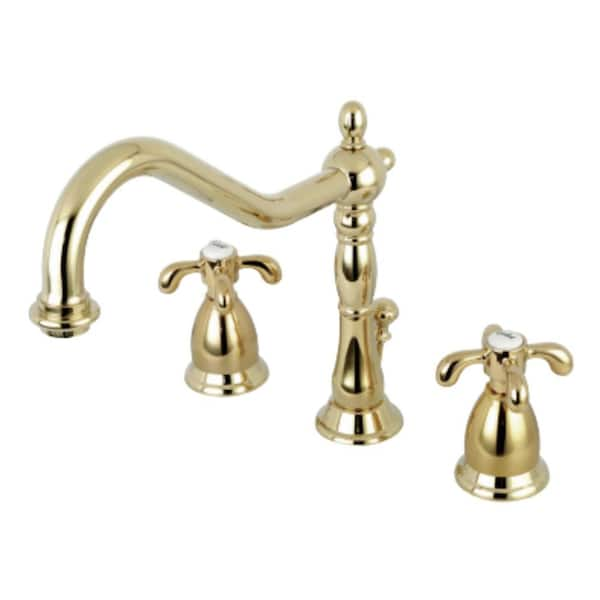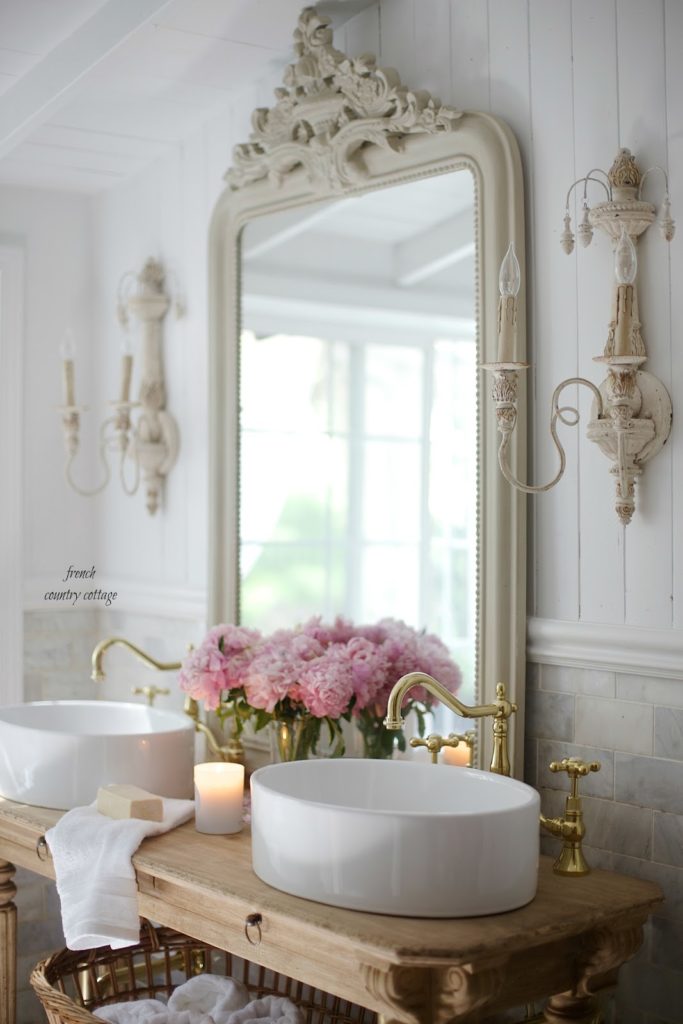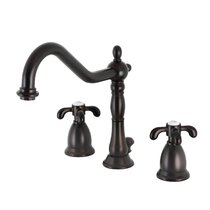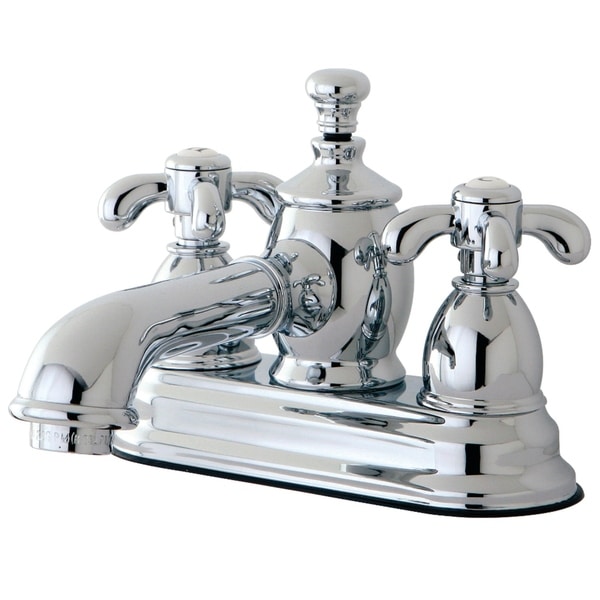Selecting the Ideal French Country Faucet Design
When it comes to choosing a French Country faucet for your bathroom, the design plays a crucial role in setting the overall tone of the space. The right faucet can transform your bathroom into a charming retreat that echoes the elegance and simplicity of the French countryside. I’ve found that selecting the perfect faucet design involves considering several key elements.
- Emphasizing Curved Lines and Classic Shapes: French Country design is all about soft, flowing lines and classic shapes. When choosing a faucet, look for designs that feature gentle curves and an old-world charm. High-arched spouts, intricate handles, and elegant silhouettes are common in French Country faucets. These design elements not only add to the aesthetic appeal but also create a sense of timeless elegance in your bathroom.
- Balancing Functionality with Style: While the design is important, it’s equally essential to consider the functionality of the faucet. French Country faucets often come with traditional cross handles or lever handles that add to their vintage charm. However, you’ll want to ensure that these handles are comfortable to use and offer smooth operation. It’s about finding that perfect balance between style and practicality, ensuring that the faucet meets your everyday needs while enhancing the bathroom’s overall look.
- Choosing a Design that Complements Your Bathroom’s Theme: The design of the faucet should complement the existing decor of your bathroom. If your bathroom features vintage elements like clawfoot tubs or beadboard walls, a French Country faucet with intricate detailing will fit right in. On the other hand, if your bathroom has a more contemporary vibe, you might opt for a more streamlined French Country faucet that still offers a touch of traditional charm without overwhelming the space.
- Considering the Size and Proportions: Another important factor is the size and proportions of the faucet. French Country faucets often have a more substantial, robust design, which can make a bold statement in the bathroom. However, it’s crucial to ensure that the faucet doesn’t overpower other elements in the space. If you have a smaller bathroom or a more delicate sink, choose a faucet that’s appropriately sized to maintain a harmonious balance in the room.
- Exploring Two-Handle vs. Single-Handle Designs: French Country faucets are available in both two-handle and single-handle designs. Two-handle faucets are more traditional and offer a classic, symmetrical look that’s very much in line with French Country aesthetics. Single-handle faucets, while slightly more modern, can still work well in a French Country bathroom, especially if they feature soft, rounded lines and vintage-inspired finishes.
- Incorporating Decorative Elements: Finally, consider faucets that incorporate decorative elements such as porcelain inlays, intricate carvings, or vintage-style accents. These details can add an extra layer of sophistication and charm to your bathroom, making the faucet not just a functional piece but a focal point in the space. Whether you choose a faucet with ornate handles or a beautifully sculpted spout, these decorative touches are what make French Country design truly special.
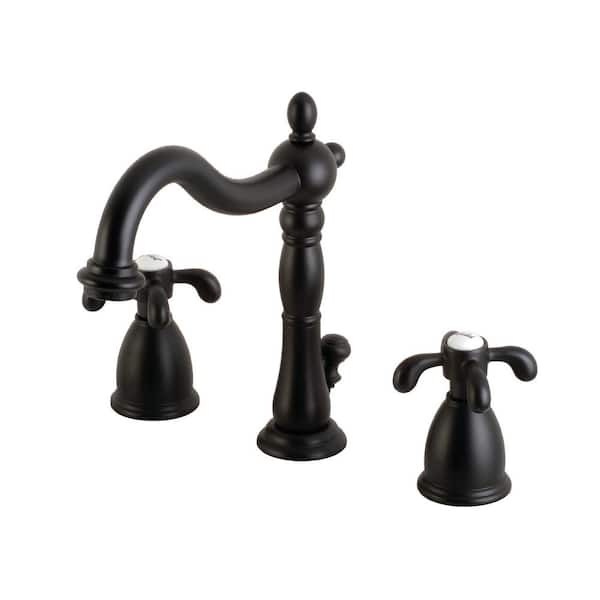
Exploring Material Choices for French Country Faucets
Choosing the right material for your French Country faucet is just as important as selecting the design. The material can significantly impact the faucet’s durability, appearance, and how well it fits into your bathroom’s overall aesthetic. Here’s a rundown of the best material options I’ve come across for French Country faucets.
The Timeless Appeal of Brass
Brass is a popular choice for French Country faucets because of its warm, rich tone and durability. It ages beautifully, developing a natural patina over time that adds to the faucet’s vintage appeal. Brass faucets are also resistant to corrosion, making them a practical choice for the bathroom. Whether polished to a high shine or left with a matte finish, brass perfectly complements the rustic elegance of French Country design.
Classic Elegance with Bronze
Bronze is another excellent material choice for French Country faucets. Oil-rubbed bronze, in particular, is favored for its deep, rich color and slightly weathered look, which fits seamlessly into the French Country aesthetic. Bronze faucets often feature intricate detailing that enhances their old-world charm. Like brass, bronze is highly durable and resistant to corrosion, making it both a stylish and practical option for your bathroom.
The Sleek Simplicity of Stainless Steel
While stainless steel might not be the first material that comes to mind for a French Country bathroom, it can work well, especially if you’re aiming for a more modern take on the style. Stainless steel is sleek, easy to maintain, and highly resistant to rust and corrosion. When paired with softer, more traditional elements in the bathroom, a stainless steel faucet can provide a nice contrast that adds interest without detracting from the overall French Country feel.
Versatility of Nickel Finishes
Nickel faucets, especially those with a brushed or satin finish, offer a subtle, sophisticated look that’s perfect for French Country bathrooms. The soft sheen of brushed nickel complements the warm, inviting atmosphere that French Country design is known for. Nickel is also highly durable and resists tarnishing, making it a low-maintenance choice that still delivers on style. Polished nickel can also be an option if you prefer a more lustrous finish.
Authentic Vintage Feel with Copper
For those who want to embrace the rustic side of French Country design, copper faucets are an excellent choice. Copper has a distinct, warm hue that can range from bright and shiny to dark and weathered, depending on the finish. It’s a material that naturally develops a patina over time, adding to the authentic, aged look. Copper faucets are not only beautiful but also have natural antimicrobial properties, making them a healthy choice for the bathroom.
Exploring Mixed Materials for a Unique Look
If you’re feeling adventurous, consider a faucet that combines different materials for a unique, custom look. For example, a faucet with a brass body and porcelain handles can offer the best of both worlds, combining warmth and vintage charm with a touch of traditional elegance. Mixed-material faucets can add depth and interest to your bathroom design, allowing you to create a truly one-of-a-kind space.
Incorporating French Country Faucets into Various Bathroom Styles
French Country faucets are incredibly versatile and can be incorporated into a variety of bathroom styles, adding a touch of rustic elegance no matter the overall design. Here are some ideas I’ve found for blending French Country faucets with different bathroom styles.
Enhancing a Traditional Bathroom
If your bathroom has a traditional design, a French Country faucet can enhance the classic feel. Traditional bathrooms often feature timeless elements like clawfoot tubs, pedestal sinks, and wainscoting. A French Country faucet with ornate detailing, cross handles, and a vintage finish like brass or oil-rubbed bronze fits seamlessly into this setting. The faucet becomes a natural extension of the traditional aesthetic, adding both functionality and style.
Adding Warmth to a Modern Bathroom
Modern bathrooms are often sleek and minimalist, with clean lines and a neutral color palette. While French Country faucets are more ornate, they can still work beautifully in a modern setting, especially if you choose a simpler design with softer curves and a polished finish. A French Country faucet can add warmth and character to a modern bathroom, creating a more inviting and personalized space without detracting from the overall modern vibe.
Complementing a Rustic Bathroom
French Country faucets are a natural fit for rustic bathrooms, which often feature natural materials, weathered finishes, and a warm, earthy color palette. In a rustic bathroom, a faucet with a distressed finish like copper or oil-rubbed bronze can enhance the space’s organic feel. The faucet’s vintage design elements, such as cross handles or an arched spout, add to the rustic charm, making the bathroom feel cozy and lived-in.
Elevating a Farmhouse Bathroom
Farmhouse bathrooms share many similarities with French Country style, making them a perfect match for French Country faucets. In a farmhouse bathroom, the faucet can feature classic design elements like a bridge-style spout or porcelain handles. The finish can range from brushed nickel for a more refined look to distressed brass for a more rustic feel. Pairing the faucet with farmhouse staples like shiplap walls, wood accents, and vintage decor creates a cohesive, charming space.
Infusing Elegance into a Vintage Bathroom
Vintage bathrooms often draw inspiration from past eras, incorporating elements like mosaic tiles, freestanding tubs, and antique furniture. A French Country faucet with a polished nickel or brass finish can add a touch of elegance to this setting. The faucet’s intricate detailing and classic design can enhance the vintage vibe, making it feel both timeless and luxurious. Pairing the faucet with vintage-inspired accessories like a framed mirror or a crystal chandelier can complete the look.
Creating a Transitional Bathroom
Transitional bathrooms blend traditional and contemporary elements, creating a balanced, harmonious space. A French Country faucet can be the perfect finishing touch in a transitional bathroom, offering the best of both worlds. Opt for a faucet with a simple yet elegant design, such as a single-handle model with a brushed nickel finish. This type of faucet can bridge the gap between the traditional and contemporary elements in the bathroom, creating a cohesive look that’s both stylish and functional.
Pairing French Country Faucets with Complementary Sink Options
Choosing the right sink to pair with your French Country faucet is key to creating a harmonious and functional bathroom design. The sink and faucet should work together to enhance the overall aesthetic of the space. Here’s what I’ve learned about finding the perfect sink to complement a French Country faucet.
Classic Pedestal Sinks for a Timeless Look
Pedestal sinks are a classic choice that pairs beautifully with French Country faucets. Their elegant, freestanding design adds a touch of sophistication to the bathroom while allowing the faucet to take center stage. Pedestal sinks come in various shapes and sizes, so you can choose one that best fits your bathroom’s proportions. A pedestal sink with a traditional shape and detailing, such as a fluted base, complements the vintage charm of a French Country faucet.
Undermount Sinks for a Seamless Appearance
For a more streamlined look, consider pairing your French Country faucet with an undermount sink. This type of sink is installed beneath the countertop, creating a seamless transition between the sink and the counter. An undermount sink allows the faucet to stand out while maintaining a clean, uncluttered look. Choose a sink with a simple, rounded shape to complement the curves of the faucet, and opt for materials like porcelain or natural stone for a refined finish.
Vessel Sinks for a Bold Statement
If you’re looking to make a bold design statement, a vessel sink can be an excellent choice. Vessel sinks sit on top of the counter, creating a striking visual focal point in the bathroom. When paired with a French Country faucet, a vessel sink can elevate the overall design, adding a touch of luxury and drama. Consider a vessel sink made of natural materials like stone or copper, which complement the rustic elegance of the faucet. The key is to choose a faucet with a high-arched spout that can reach over the vessel sink comfortably.
Drop-In Sinks for Versatility
Drop-in sinks, also known as self-rimming or top-mount sinks, are a versatile option that works well with French Country faucets. These sinks are easy to install and come in a wide range of shapes, sizes, and materials. A drop-in sink with a wide rim and classic design can enhance the traditional appeal of a French Country faucet. For a cohesive look, choose a sink with a finish that complements the faucet, such as porcelain or enameled cast iron.
Console Sinks for Vintage Charm
Console sinks, which combine a basin with legs or a metal stand, are another great option for pairing with French Country faucets. These sinks offer a vintage look that’s perfect for traditional or farmhouse-style bathrooms. The open design of a console sink allows the faucet to be a focal point, while the sink’s legs add an extra touch of elegance. Console sinks often feature metal or ceramic legs, which can be matched to the faucet’s finish for a cohesive look.
Farmhouse Sinks for a Rustic Touch
For a more rustic, country-inspired bathroom, consider pairing your French Country faucet with a farmhouse sink. Also known as an apron-front sink, this type of sink is characterized by its deep basin and exposed front panel. A farmhouse sink made of fireclay or porcelain complements the vintage charm of a French Country faucet, while its large size provides plenty of space for washing up. The combination of a farmhouse sink and a French Country faucet creates a warm, inviting space that feels both practical and stylish.
The Role of Finish in French Country Faucet Aesthetics
The finish of a French Country faucet plays a significant role in its overall aesthetic and how it contributes to the bathroom’s design. The right finish can enhance the faucet’s beauty, durability, and ability to complement other elements in the space. Here’s what I’ve discovered about the importance of finish in French Country faucet design.
Enhancing Vintage Charm with Oil-Rubbed Bronze
Oil-rubbed bronze is a popular finish choice for French Country faucets due to its rich, dark color and slightly weathered look. This finish enhances the vintage charm of the faucet, giving it an antique appearance that fits seamlessly into a rustic or traditional bathroom. Oil-rubbed bronze also pairs well with warm, earthy tones and natural materials, creating a cozy, inviting atmosphere in the bathroom.
Achieving a Polished Look with Brushed Nickel
Brushed nickel is another excellent finish option for French Country faucets, offering a softer, more subtle sheen than polished chrome. This finish is perfect for those who want to achieve a polished, elegant look without the high shine. Brushed nickel is also highly durable and resistant to fingerprints and water spots, making it a practical choice for busy bathrooms. Its versatility allows it to complement a wide range of bathroom styles, from traditional to contemporary.
Adding Warmth with Polished Brass
Polished brass is a classic finish that brings warmth and a touch of luxury to French Country faucets. The golden hue of polished brass adds an element of richness to the bathroom, making it feel more sophisticated and inviting. This finish works particularly well in bathrooms with warm color palettes or vintage decor. Over time, polished brass can develop a natural patina, adding to the faucet’s character and charm.
Creating Contrast with Matte Black
For a more modern take on French Country design, consider a faucet with a matte black finish. Matte black creates a striking contrast with lighter, more traditional elements in the bathroom, adding depth and visual interest. This finish is also highly versatile, working well in both rustic and contemporary settings. Matte black is known for its durability and resistance to wear, making it a stylish yet practical choice for French Country faucets.
Opting for Timeless Appeal with Polished Chrome
Polished chrome is a timeless finish that adds a sleek, reflective quality to French Country faucets. While it may seem more modern, polished chrome can still work beautifully in a French Country bathroom, especially when paired with other vintage-inspired elements. The high shine of polished chrome reflects light, making the bathroom feel brighter and more open. It’s also easy to clean and maintain, making it a popular choice for those who want both style and convenience.
Exploring Mixed Finishes for a Unique Look
If you’re looking to create a more personalized bathroom design, consider using mixed finishes on your French Country faucet. For example, a faucet with a brushed nickel body and oil-rubbed bronze handles can offer the best of both worlds, combining elegance with a touch of rustic charm. Mixed finishes can add depth and interest to the faucet, making it a focal point in the bathroom. The key is to choose finishes that complement each other while enhancing the overall aesthetic of the space.
Installing French Country Faucets: Tips and Considerations
Installing a French Country faucet can be a rewarding project that adds both beauty and functionality to your bathroom. However, it’s important to approach the installation with care to ensure that everything goes smoothly. Here are some tips and considerations I’ve gathered from my own experiences and research.
Choosing the Right Faucet for Your Sink
Before you start the installation, it’s crucial to choose a faucet that’s compatible with your sink. French Country faucets come in a variety of styles, including single-hole, centerset, and widespread configurations. Make sure to measure the existing holes in your sink or countertop to determine the correct faucet type. If you’re installing a new sink along with the faucet, you’ll have more flexibility in choosing the faucet style.
Gathering the Necessary Tools and Materials
Proper preparation is key to a successful installation. Gather all the tools and materials you’ll need before starting the project. This typically includes a basin wrench, plumber’s tape, a screwdriver, and a bucket to catch any water that might spill during the installation. Having everything on hand will save you time and help the installation process go more smoothly.
Turning Off the Water Supply
One of the most important steps before installing a new faucet is to turn off the water supply. Locate the shut-off valves under the sink and turn them clockwise to stop the flow of water. If your bathroom doesn’t have individual shut-off valves, you may need to turn off the main water supply to your home. Once the water is off, open the faucet to drain any remaining water from the lines.
Removing the Old Faucet
If you’re replacing an old faucet, you’ll need to remove it before installing the new one. Start by disconnecting the water supply lines from the faucet. Use a basin wrench to loosen the nuts that hold the faucet in place. Once the nuts are removed, you should be able to lift the old faucet out of the sink or countertop. Be sure to clean the area thoroughly before installing the new faucet.
Installing the New French Country Faucet
Follow the manufacturer’s instructions carefully when installing your new French Country faucet. Begin by placing the faucet’s gasket or seal over the mounting holes to prevent leaks. Insert the faucet into the holes and secure it in place with the mounting nuts. Tighten the nuts using a basin wrench, being careful not to overtighten and damage the sink or faucet. Once the faucet is secure, connect the water supply lines and turn the water back on to check for leaks.
Finishing Touches and Final Checks
After the faucet is installed, it’s time to add the finishing touches. Attach any handles, decorative caps, or other accessories that came with the faucet. Test the faucet to ensure that it’s working properly and that there are no leaks. Check the water pressure and make any necessary adjustments. If everything is in order, your new French Country faucet is ready to use, adding a touch of elegance and charm to your bathroom.
Maintaining the Elegance of French Country Faucets
Once you’ve installed your French Country faucet, keeping it in top condition is essential to preserving its beauty and functionality. Regular maintenance will ensure that your faucet continues to enhance your bathroom for years to come. Here’s what I’ve learned about maintaining French Country faucets.
Regular Cleaning to Prevent Buildup
The first step in maintaining your French Country faucet is regular cleaning. Over time, mineral deposits, soap scum, and water spots can build up on the faucet, dulling its finish. To keep the faucet looking its best, clean it regularly with a soft cloth and a mild, non-abrasive cleaner. Avoid using harsh chemicals or abrasive scrubbers, as these can damage the finish. For stubborn buildup, a mixture of vinegar and water can be an effective and natural cleaning solution.
Polishing to Restore Shine
Depending on the finish of your French Country faucet, you may need to polish it occasionally to restore its shine. For polished brass or chrome finishes, use a gentle metal polish to remove the tarnish and bring back the faucet’s luster. Be sure to follow the manufacturer’s recommendations for polishing and avoid over-polishing, which can wear down the finish over time. For matte or brushed finishes, a simple wipe-down with a damp cloth is usually sufficient to maintain the faucet’s appearance.
Checking for Leaks and Drips
Regularly check your faucet for leaks or drips, as these can indicate a problem that needs to be addressed. A leaking faucet can waste water and lead to higher utility bills, as well as cause damage to your sink or countertop over time. If you notice a leak, it’s important to fix it promptly. In many cases, a worn-out washer or O-ring is the culprit and can be easily replaced. If the problem persists, it may be necessary to consult a professional plumber.
Tightening Loose Handles and Fixtures
Over time, the handles and fixtures of your French Country faucet may become loose due to regular use. To prevent this from becoming a bigger issue, check the faucet’s handles and other components periodically to ensure they are securely fastened. Use a screwdriver or the appropriate tool to tighten any loose screws or fittings. This simple maintenance task can prolong the life of your faucet and prevent more significant problems from developing.
Replacing Worn-Out Parts
Even with regular maintenance, certain parts of your French Country faucet may wear out over time and need to be replaced. Common parts that may require replacement include washers, O-rings, and cartridges. If you notice that your faucet is no longer functioning as it should, or if it has become difficult to operate, it may be time to replace one or more of these components. Refer to the manufacturer’s instructions for guidance on how to replace parts, or consult a professional plumber if needed.
Protecting the Faucet from Damage
Finally, it’s important to protect your French Country faucet from damage to keep it looking and functioning its best. Avoid using the faucet as a support or hanging heavy items on it, as this can cause strain and lead to damage. Be mindful when using cleaning products around the faucet, and wipe up any spills immediately to prevent staining or corrosion. By taking these precautions, you can enjoy the elegance of your French Country faucet for many years to come.
Common Mistakes to Avoid
While French Country faucets can add a beautiful and timeless touch to your bathroom, there are a few common mistakes that people often make when choosing, installing, and maintaining these fixtures. By being aware of these potential pitfalls, you can ensure that your faucet not only looks great but also functions properly for years to come.
Choosing the Wrong Finish
One of the most common mistakes is choosing a faucet finish that doesn’t complement the rest of the bathroom’s design. While it’s tempting to pick a finish based solely on personal preference, it’s important to consider how it will look with other elements in the room. For example, an oil-rubbed bronze finish may clash with a bathroom that features a lot of chrome or stainless steel. To avoid this mistake, take the time to coordinate your faucet finish with your bathroom’s overall color scheme and design style.
Overlooking the Sink Compatibility
Another common mistake is not considering the compatibility of the faucet with the sink. French Country faucets come in various configurations, such as single-hole, centerset, and widespread. It’s crucial to choose a faucet that fits the existing holes in your sink or countertop. If you’re installing a new sink, make sure it’s designed to accommodate the type of faucet you’ve chosen. Failing to do so can lead to a complicated installation process and may require additional modifications to your sink or countertop.
Improper Installation Techniques
Improper installation is another common mistake that can lead to a host of problems down the road. Whether you’re installing the faucet yourself or hiring a professional, it’s essential to follow the manufacturer’s instructions carefully. Skipping steps, using the wrong tools, or not securing the faucet properly can result in leaks, loose handles, and other issues. If you’re unsure about the installation process, it’s always best to consult a professional plumber to ensure everything is done correctly.
Neglecting Regular Maintenance
Once the faucet is installed, neglecting regular maintenance is a mistake that can shorten its lifespan. Regular cleaning, polishing, and checking for leaks are all important tasks that help keep the faucet in good condition. Failing to maintain the faucet can lead to mineral buildup, tarnished finishes, and other issues that detract from its appearance and functionality. Set a schedule for regular maintenance and stick to it to keep your faucet looking and working its best.
Ignoring Water Pressure Requirements
French Country faucets, like all faucets, have specific water pressure requirements to function properly. Ignoring these requirements can lead to poor water flow, leaks, and other problems. Before installing the faucet, check the manufacturer’s specifications for the recommended water pressure range. If your home’s water pressure is too high or too low, you may need to install a pressure regulator or make other adjustments to ensure the faucet works correctly.
Mismatched Accessories and Hardware
Finally, another common mistake is mismatching accessories and hardware with the French Country faucet. While the faucet itself may be beautiful, it can look out of place if the surrounding accessories and hardware don’t match. For example, pairing a French Country faucet with modern, minimalist hardware can create a disjointed look. To avoid this mistake, choose accessories and hardware that complement the faucet’s style and finish, creating a cohesive and harmonious bathroom design.
What is a French Country faucet?
A French Country faucet is a type of bathroom fixture that embodies the rustic, yet elegant design aesthetic of the French countryside. These faucets often feature traditional shapes, detailed craftsmanship, and finishes that evoke a sense of timeless charm. They are designed to complement bathrooms with classic or farmhouse-inspired decor, adding a touch of old-world elegance and warmth.
How do I choose the right finish for a French Country faucet?
When choosing a finish for your French Country faucet, consider the overall design and color scheme of your bathroom. Popular finishes for French Country faucets include oil-rubbed bronze, brushed nickel, polished brass, matte black, and polished chrome. The finish should complement other elements in the bathroom, such as the sink, countertop, and hardware. It’s also important to consider the durability and maintenance requirements of the finish, as some may require more upkeep than others.
Can I install a French Country faucet myself?
Yes, it’s possible to install a French Country faucet yourself if you have some basic plumbing knowledge and the right tools. However, it’s important to follow the manufacturer’s instructions carefully to ensure a proper installation. If you’re unsure about any aspect of the installation process, it’s recommended to consult a professional plumber to avoid potential issues such as leaks or improper alignment.
How do I maintain a French Country faucet?
Maintaining a French Country faucet involves regular cleaning, polishing, and checking for leaks or drips. Use a soft cloth and a mild cleaner to clean the faucet regularly, avoiding harsh chemicals or abrasive scrubbers that can damage the finish. Depending on the finish, you may need to polish the faucet occasionally to restore its shine. It’s also important to check for any loose handles or fixtures and tighten them as needed to ensure the faucet continues to function properly.
What type of sink works best with a French Country faucet?
French Country faucets can be paired with a variety of sink types, depending on the desired look and functionality. Pedestal sinks, undermount sinks, vessel sinks, drop-in sinks, console sinks, and farmhouse sinks are all compatible options. The key is to choose a sink that complements the faucet’s style and finish while fitting the bathroom’s overall design. Consider the size and shape of the sink, as well as its material, to create a cohesive and harmonious look.
Are French Country faucets durable?
French Country faucets are generally durable and built to last, especially when made from high-quality materials such as brass or stainless steel. However, the durability of the faucet also depends on the finish and how well it’s maintained. Regular cleaning and maintenance can help preserve the faucet’s appearance and functionality over time. If you’re concerned about durability, look for faucets with a solid warranty and choose a reputable brand known for quality craftsmanship.
Related Posts:
- Bathroom Faucet Escutcheon Plate
- Arts And Crafts Style Bathroom Faucets
- Brass Single Handle Bathroom Faucet
- Stainless Steel Bathroom Faucet Single Hole
- Gingers Bathroom Faucets
- How Do You Fix A Leaky Moen Bathroom Faucet
- Moen Bathroom Faucet Installation Instructions
- Delta Bathroom Faucet Aerator Replacement
- Kohler Revival Bathroom Faucet
- Ceramic Handle Bathroom Faucet
